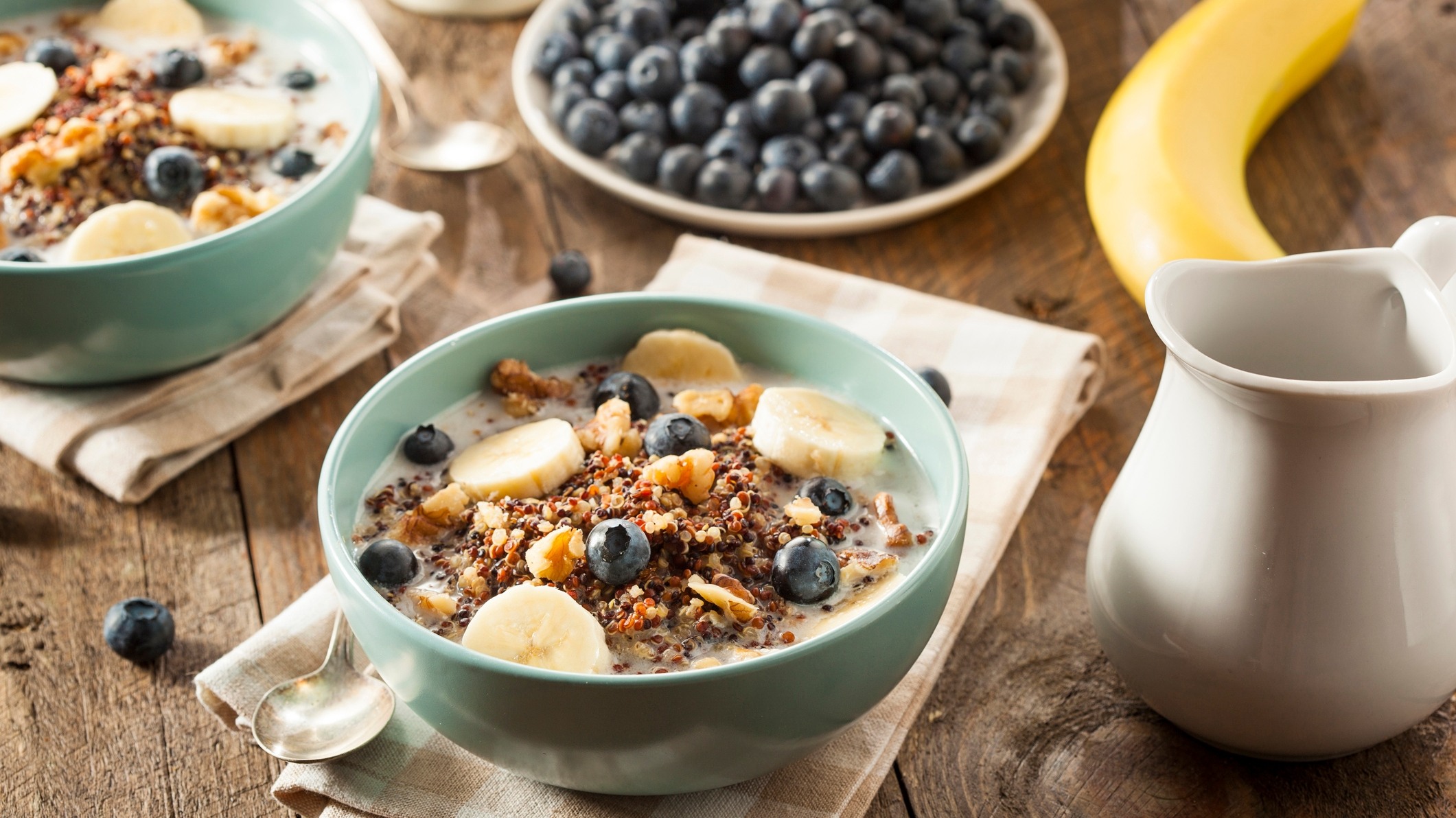Start Your Day Right: 5 Ways to Make Breakfast Healthier
October 22, 2018 | Food Lion


It's easy to just grab a cup of Joe and a piece of toast to start your day. But it's high time you give your body the breakfast it deserves.
"Your first meal of the day gives you the energy to power you through your morning and sets the tone for the rest of the day's food choices," says Jessica Cording, RD, a dietician based in New York City.
So, instead of the pastries and muffins that have most likely become your morning staple, here's how to give your breakfast a healthy makeover.
1. Find balance. "Eat a breakfast that combines a balance of protein and complex carbohydrates to provide stable energy through the morning," says Cording. (You should be aiming for 50% carbohydrates, 20% protein, and 30% fats.) Focus on mainly whole foods to help you be more aware of what you're consuming. For example, eggs, plain Greek yogurt, and nuts are all great sources of protein. Reach for fresh fruit (bottled juice may sound healthy, but hits your bloodstream like a sugar bomb), veggies, healthy fats like avocado, and whole grains for carbs.
2. Read labels. Are you a freezer foodie? You're not alone: approximately 80 percent of consumers eat frozen breakfast foods, with 25 percent eating them on the go. But don't just grab a frozen waffle and make a run for it. “Check out the nutrition labels and look for products that are lower in sugar and sodium as well as those made with whole grains instead of refined grains," says Cording. Likewise, raise the bar on your breakfast bar. While they are arguably the easiest breakfast products to grab and eat on the go, nutrition bars can also be high in sugar, fat and calories. Look for gluten-free, low sugar oats, millet, buckwheat, amaranth, quinoa, seeds and nuts for protein. Kind Bars, for example, boast a whole grain blend (oats, brown rice, millet, oat flour, buckwheat, amaranth, and quinoa), along with nuts and seeds. Another brand, Kashi, has a signature "7 Whole Grains & Sesame blend" in their cereal and bar products.
3. Amp up your cold cereal. The most popular breakfast in America? Ready-to-eat cold cereal (93 percent of Americans say that's their go-to breakfast, according to a trend survey published in Food Technology magazine.) If you opt for cereal in the morning, choose one with whole grains listed first in the ingredients list, and keep an eye on sugar. “Ideally, I recommend a cereal with less than five grams sugar, and at least four grams of fiber per serving," says Cording, who points to bran flakes and shredded wheat cereals as good options. “Top it with fresh berries [a ½ cup of blueberries, for example, will give you two additional grams of fiber] and opt for skim or 1-percent milk for protein," says Cording. If you're lactose-intolerant or follow a dairy-free diet, use an unsweetened dairy-free milk, but be mindful that many of them have very little protein, so you may want to add a couple tablespoons of chopped nuts for a little more staying power.
4. Eat in, not out. It's so easy to grab breakfast at a convenience store, fast-food restaurant, or deli. But many restaurants serve oversized portions, so consider wrapping some up for later, says Cording. And beware of the convenience foods that seem healthy but actually aren't: "Wraps and breakfast burritos are often huge and use rice or potatoes as filling, while pre-made yogurt parfaits are often loaded with sugar," says Cording. To keep portions and ingredients in check, DIY breakfast to-go the night before. "Make your own parfait with plain yogurt, fresh fruit, and ¼ cup of granola, max," says Cording. And whip up your own breakfast wrap using eggs and veggies.
5. When in doubt, blend. When all else fails, make a smoothie-to-go with frozen fruit, frozen veggies, and plain yogurt or tofu. “Be careful you're not getting a big hit of sugar from added juice or sweetened yogurt or non-dairy milk," says Cording. "Ideally, you want mostly veggies, a little fruit, and some kind of protein, whether from milk, plain yogurt, or protein powder. Hamilton Beach makes a Single Serve Blender so you can blend your smoothie and then take it to-go in the same container. Sip it down while you multi-task, whether you're checking emails, dropping the kids off at school, or strolling through the supermarket aisles.
It's easy to just grab a cup of Joe and a piece of toast to start your day. But it's high time you give your body the breakfast it deserves.
"Your first meal of the day gives you the energy to power you through your morning and sets the tone for the rest of the day's food choices," says Jessica Cording, RD, a dietician based in New York City.
So, instead of the pastries and muffins that have most likely become your morning staple, here's how to give your breakfast a healthy makeover.
1. Find balance. "Eat a breakfast that combines a balance of protein and complex carbohydrates to provide stable energy through the morning," says Cording. (You should be aiming for 50% carbohydrates, 20% protein, and 30% fats.) Focus on mainly whole foods to help you be more aware of what you're consuming. For example, eggs, plain Greek yogurt, and nuts are all great sources of protein. Reach for fresh fruit (bottled juice may sound healthy, but hits your bloodstream like a sugar bomb), veggies, healthy fats like avocado, and whole grains for carbs.
2. Read labels. Are you a freezer foodie? You're not alone: approximately 80 percent of consumers eat frozen breakfast foods, with 25 percent eating them on the go. But don't just grab a frozen waffle and make a run for it. “Check out the nutrition labels and look for products that are lower in sugar and sodium as well as those made with whole grains instead of refined grains," says Cording. Likewise, raise the bar on your breakfast bar. While they are arguably the easiest breakfast products to grab and eat on the go, nutrition bars can also be high in sugar, fat and calories. Look for gluten-free, low sugar oats, millet, buckwheat, amaranth, quinoa, seeds and nuts for protein. Kind Bars, for example, boast a whole grain blend (oats, brown rice, millet, oat flour, buckwheat, amaranth, and quinoa), along with nuts and seeds. Another brand, Kashi, has a signature "7 Whole Grains & Sesame blend" in their cereal and bar products.
3. Amp up your cold cereal. The most popular breakfast in America? Ready-to-eat cold cereal (93 percent of Americans say that's their go-to breakfast, according to a trend survey published in Food Technology magazine.) If you opt for cereal in the morning, choose one with whole grains listed first in the ingredients list, and keep an eye on sugar. “Ideally, I recommend a cereal with less than five grams sugar, and at least four grams of fiber per serving," says Cording, who points to bran flakes and shredded wheat cereals as good options. “Top it with fresh berries [a ½ cup of blueberries, for example, will give you two additional grams of fiber] and opt for skim or 1-percent milk for protein," says Cording. If you're lactose-intolerant or follow a dairy-free diet, use an unsweetened dairy-free milk, but be mindful that many of them have very little protein, so you may want to add a couple tablespoons of chopped nuts for a little more staying power.
4. Eat in, not out. It's so easy to grab breakfast at a convenience store, fast-food restaurant, or deli. But many restaurants serve oversized portions, so consider wrapping some up for later, says Cording. And beware of the convenience foods that seem healthy but actually aren't: "Wraps and breakfast burritos are often huge and use rice or potatoes as filling, while pre-made yogurt parfaits are often loaded with sugar," says Cording. To keep portions and ingredients in check, DIY breakfast to-go the night before. "Make your own parfait with plain yogurt, fresh fruit, and ¼ cup of granola, max," says Cording. And whip up your own breakfast wrap using eggs and veggies.
5. When in doubt, blend. When all else fails, make a smoothie-to-go with frozen fruit, frozen veggies, and plain yogurt or tofu. “Be careful you're not getting a big hit of sugar from added juice or sweetened yogurt or non-dairy milk," says Cording. "Ideally, you want mostly veggies, a little fruit, and some kind of protein, whether from milk, plain yogurt, or protein powder. Hamilton Beach makes a Single Serve Blender so you can blend your smoothie and then take it to-go in the same container. Sip it down while you multi-task, whether you're checking emails, dropping the kids off at school, or strolling through the supermarket aisles.






Create Your Display Name